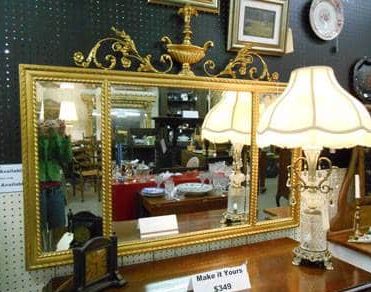
Labarge mirrors are known for their exquisite craftsmanship and timeless beauty. These mirrors have been a popular choice for interior designers and collectors alike for decades, with many people seeking out their unique style and quality.
However, identifying a genuine Labarge mirror can be a daunting task, as there are many imitations on the market. That’s why we’ve put together the ultimate guide to identifying a Labarge mirror, complete with tips and tricks to help you determine whether you’re looking at a real Labarge or a fake. From examining the mirror’s frame and glass to checking for the signature Labarge label, we’ll cover everything you need to know to confidently identify a Labarge mirror. Whether you’re a collector or simply looking to add a touch of elegance to your home, this guide will provide you with the knowledge and expertise necessary to make an informed purchase. So let’s dive in and discover the world of Labarge mirrors together!
Labarge mirrors are valuable because of their unique style and high-quality craftsmanship. They are known for their ornate and intricate frames that are often made of brass, silver, gold, or wood. Additionally, the mirrors are handcrafted and finished with precision, making them a timeless piece of art. The mirrors were produced by Labarge Inc., a company that was founded in 1940 by Robert and Jean LaBarge in Michigan. The company gained a reputation for producing high-end mirrors that were sold in luxury department stores such as Neiman Marcus, Saks Fifth Avenue, and Bloomingdale’s.
Characteristics and features of Labarge mirrors
Labarge mirrors are characterized by their ornate and intricate frames that are often made of brass, silver, gold, or wood. The frames are adorned with intricate details such as flowers, leaves, and scrolls, making them a beautiful addition to any room. Additionally, the mirrors are often quite large, making them a statement piece in any space. The glass used in Labarge mirrors is of high quality, and it is often beveled or convex, adding to its unique look.
Identifying a Labarge mirror: Tips and tricks
Identifying a genuine Labarge mirror can be challenging, as there are many imitations on the market. However, there are a few things you can look for to ensure that you are purchasing a genuine Labarge mirror. First, look for the signature Labarge label on the back of the mirror. This label will often include the company’s logo and the mirror’s model number. Additionally, examine the frame closely. Genuine Labarge mirrors will have intricate and detailed frames, with no signs of mass production. Imitations, on the other hand, will often have less detail and be made of cheaper materials.
Another way to identify a genuine Labarge mirror is to examine the glass. Labarge mirrors are known for their high-quality glass, which is often beveled or convex. Additionally, the glass is often cut to fit the frame perfectly, with no gaps or overlaps. Finally, examine the back of the mirror. Genuine Labarge mirrors will have a solid backing, while imitations may have a flimsy or poorly constructed backing.
Tools you need to identify a Labarge mirror
To identify a Labarge mirror, you will need a few tools. These include a magnifying glass, a flashlight, and a ruler. The magnifying glass will help you examine the intricate details of the frame and the glass, while the flashlight will help you see any hidden details. The ruler will help you measure the size of the mirror and ensure that it is the correct size for a Labarge mirror.
How to date a Labarge mirror
Dating a Labarge mirror can be challenging, as the company did not include date stamps on their mirrors. However, there are a few things you can look for to help you determine the age of the mirror. First, examine the frame closely. Labarge mirrors produced in the 1940s and 1950s will often have brass or silver frames, while those produced in the 1960s and 1970s will often have gold or wood frames. Additionally, examine the style of the frame. Labarge mirrors produced in the 1940s and 1950s will often have a more traditional style, while those produced in the 1960s and 1970s may have a more modern or abstract style.
How to clean and maintain a Labarge mirror
To keep your Labarge mirror looking its best, it is important to clean and maintain it regularly. Start by dusting the frame and glass with a soft cloth or feather duster. If the mirror is particularly dirty, you can use a mixture of warm water and mild soap to clean the glass. Be sure to dry the mirror thoroughly with a clean, dry cloth to prevent water spots. Additionally, avoid hanging the mirror in direct sunlight, as this can cause the frame and glass to fade or discolor over time.
Where to buy Labarge mirrors
Labarge mirrors are highly sought after, and they can be found in a variety of locations. You may be able to find them at your local antique store or flea market. Additionally, online retailers such as eBay and Etsy may have a selection of Labarge mirrors available for purchase. When purchasing a Labarge mirror, be sure to examine it closely and look for the signature Labarge label to ensure that it is genuine.
Labarge mirror pricing and value
The value of a Labarge mirror can vary depending on a variety of factors, including its age, condition, and rarity. Antique Labarge mirrors can sell for thousands of dollars, while more modern mirrors may be less expensive. Additionally, the value of a Labarge mirror may increase over time, making it a valuable investment for collectors.
